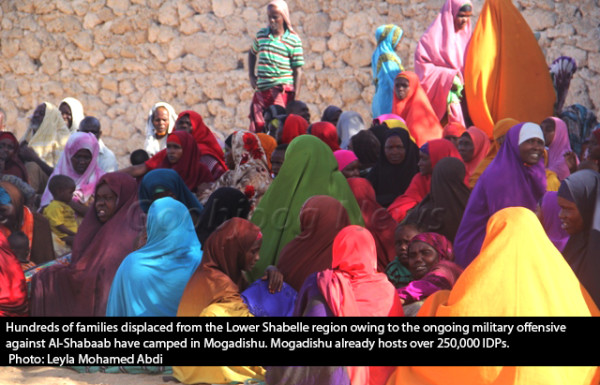Military offensives and Al-Shabaab threats in Lower Shabelle force families to flee to Mogadishu

By Leyla Mohamed Abdi
Renewed military offensive against Al-Shabaab fighters by Somali government forces backed by African Union AMISOM troops has sparked another influx of civilians to the capital Mogadishu in the last two months.
Some 250 families have arrived in Mogadishu fleeing the fighting or the fear of fighting in their home areas especially Lower Shabelle region in the last two months.
The families are now housed in internally displaced persons, IDP camps in Tabelaha area in Daynille district in Mogadishu.
Most of these people came from Janaale in Lower Shabelle region where AMISOM and SNA launched new offensives to liberate the areas under the control of Al-Shabaab fighters in the last few months.
We sneaked out at night
Shariifo Siidow, a mother of five, came to Mogadishu a month ago from the Lower Shabelle region with nine other families. “We left our home near Janaale town because we were afraid. There are so many planes flying low and Al-Shabaab is forcing people to join the fighting,” said Siidow.
She said they had to sneak out of town at night because Al-Shabaab “does not allow anyone to leave but I am sure many more w ill leave because everyone is afraid of what is coming”.
Al-Shabab still controls some parts of southern Somalia, despite pressure from SNA troops African Union.

So far, the displaced are staying in a temporary camp in the south of the city, said Siidow.
“There is likelihood that more displaced people would be coming to Mogadishu in the next few weeks if the conflict in Lower Shabelle region escalates,” says Abdi Mohamed director of a local nongovernmental organisation operating in Mogadishu.
Drought conditions
As drought conditions ease out in the country, many of the displaced have begun to return home but the renewed fighting in parts of southern Somalia is likely to complicate their return,” said Mohamed. “We should not be talking about resettlement in the midst of conflict but rather emergency assistance to those who are coming daily.”
He added humanitarian agencies are concerned about the impact of movements of people from the Janaale town and the fragile humanitarian situation in Mogadishu where displaced people are already living in precarious conditions.”

Mogadishu is already home to more than 250,000 internally displaced people most of whom were displaced by the 2011 famine which killed over 200,000 others.
Mohamed pointed out that the escalation of hostilities deeper into Janaale town will likely lead to an additional influx of hundreds of people into Mogadishu, straining the capacity of the camps and host communities.
“Humanitarian agencies in Mogadishu are doing everything within their capability to provide immediate help to those most in need wherever they are. They have also been assessing the capacity of existing assistance structures and stocks available to extend assistance to the additional population in need and target, in particular, the most vulnerable families,” said Mohamed.